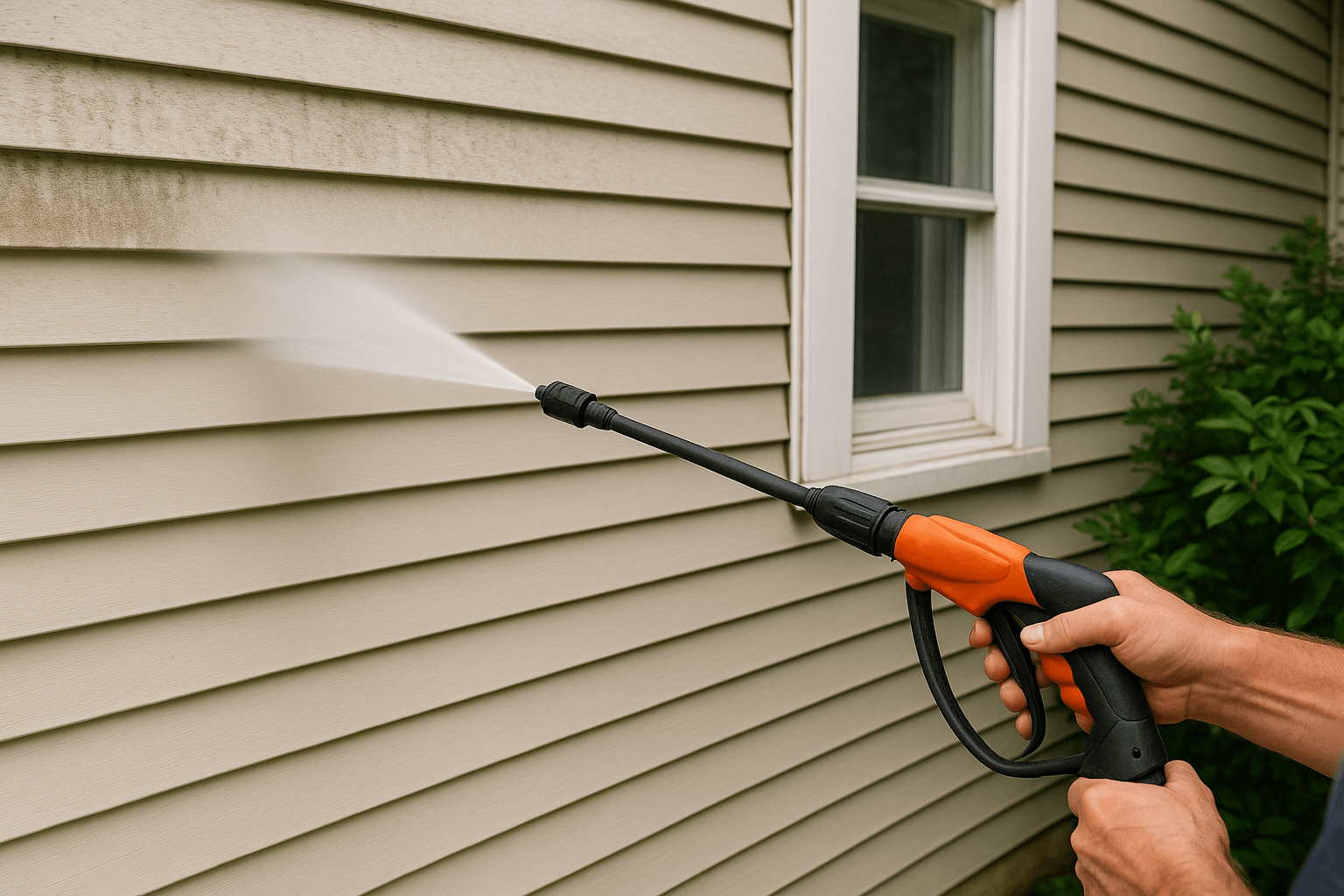Can You Pressure Wash Aluminum Siding? Safe Methods, Tips & Mistakes to Avoid

Yes, you can pressure wash aluminum siding safely, but only if done correctly. Over time, aluminum siding gathers dirt, oxidation, grime, and mildew, reducing your home's curb appeal. Pressure washing effectively removes these issues, restoring your home's appearance and protecting your investment. However, using incorrect techniques or equipment can cause dents, strip paint, or lead to water damage.
In this guide, you'll learn exactly how to pressure wash aluminum siding safely, avoid common mistakes, and keep your siding looking great for years.
Alternatives to Pressure Washing Aluminum Siding
Soft washing Method
Soft washing uses low-pressure water combined with specialized, eco-friendly cleaning solutions. This method effectively removes dirt, grime, mildew, and oxidation without risking dents or paint damage. It's ideal for homeowners who prefer a gentler yet thorough cleaning approach.
Manual Scrubbing Options
For small or sensitive areas, manual scrubbing can be effective. Use a soft-bristle brush, warm water, and a mild detergent specifically designed for aluminum siding. Although this requires more physical effort and time, manual cleaning offers complete control, minimizing the risk of accidental damage.
When to Consider Professional Cleaning Services
Professional cleaning is highly advisable if your siding is significantly oxidized, has extensive peeling paint, or structural issues like loose panels. Experts have specialized equipment and experience to safely clean and restore your aluminum siding, ensuring optimal results without the DIY risks.
Benefits of Pressure Washing Aluminum Siding
Pressure washing aluminum siding effectively removes stubborn dirt, grime, algae, mildew, and oxidation that can accumulate over time. Compared to repainting or completely replacing your siding, pressure washing is significantly more cost-effective, offering substantial savings while achieving impressive results. Additionally, this cleaning method instantly boosts your home's curb appeal, potentially increasing its overall value and attractiveness.
Risks of Pressure Washing Aluminum Siding
While pressure washing aluminum siding is effective, improper use can lead to potential damage. High water pressure or incorrect nozzle settings may cause dents, strip away paint, or loosen siding panels. Additionally, incorrect spraying angles can allow water to penetrate behind the siding, leading to moisture problems, mold growth, or structural damage. To avoid these risks, it's essential to use appropriate techniques, correct equipment settings, and carefully follow recommended practices.
How to Pressure Wash Aluminum Siding Safely
Pressure washing is a great way to clean aluminum siding safely and effectively. By following proper steps, you can ensure the siding remains undamaged and looks its best.
Step 1: Inspect and Prepare Your Siding
Before beginning, thoroughly inspect your siding for any damage, loose panels, or problematic areas. Secure or repair any loose sections to prevent further damage. Additionally, protect your surroundings by covering electrical outlets, windows, landscaping, and outdoor furniture. Always wear safety goggles, gloves, long sleeves, and sturdy footwear to protect yourself during pressure washing.
Step 2: Choose the Right Pressure Washer & Settings
For aluminum siding, selecting the right pressure washer settings is critical. Aim for a PSI level between 1200 and 1600 to safely clean without damaging the siding. Use a 25-degree nozzle tip for heavier cleaning tasks and a 40-degree nozzle for gentle washing.
Step 3: Pre-Rinse & Loosen Dirt
Start by rinsing your siding from top to bottom with plain water. This pre-rinse loosens dirt and debris, making the cleaning process more efficient.
Step 4: Selecting and Applying the Best Detergent
Choose a detergent specifically formulated for aluminum siding, such as Simple Green House and Siding Cleaner or Krud Kutter House Wash. Apply the detergent from bottom to top to prevent streaking and ensure even coverage.
Step 5: Proper Washing Technique
To clean aluminum siding safely, maintain a downward spray angle of approximately 45 degrees, keeping the nozzle 12-18 inches from the siding surface. Use a smooth, side-to-side motion, working methodically from the top down to avoid streaks and ensure thorough cleaning.
Step 6: Thorough Rinsing and Post-Wash Inspection
After washing, thoroughly rinse the siding from top to bottom to remove any remaining detergent or residue. Conduct a careful post-cleaning inspection to check for missed areas or newly exposed damage.
Can You Pressure Wash Damaged Aluminum Siding?
Yes, you can pressure wash aluminum siding even if it's slightly damaged, but precautions must be taken based on the type and severity of the damage.
Pressure Washing Aluminum Siding with Minor Damage (Dents or Scratches)
If your siding has minor dents or scratches, reduce the PSI settings to 1000-1200 and maintain a nozzle distance of at least 18-24 inches. Use gentle, careful motions to avoid exacerbating existing damage.
Pressure Washing Aluminum Siding with Peeling Paint or Severe Oxidation
Pressure washing siding with peeling paint or severe oxidation carries risks, such as stripping paint or creating an uneven finish. Use a significantly lower pressure setting and maintain a greater distance (24 inches or more). If damage is extensive, consider repainting or hiring professionals to ensure a quality restoration.
When NOT to Pressure Wash Aluminum Siding (Severe Damage & Loose Panels)
Avoid pressure washing siding with severe structural damage or loose panels. This can worsen existing issues and lead to further damage. Instead, first repair or replace damaged areas, or seek professional evaluation before attempting any cleaning.
Common Mistakes to Avoid While Pressure Washing Aluminum Siding
When pressure washing aluminum siding, it's important to avoid several common mistakes that can lead to damage or poor results. One significant error is using excessive pressure. Higher pressure settings might seem efficient but can easily cause dents, strip paint, or damage the siding surface.
Incorrect nozzle or angle selection is another frequent mistake. A nozzle that produces too concentrated a spray can cause harm, while an improper spray angle might push water behind the siding, potentially causing water damage or mold growth.
Skipping critical steps such as the initial pre-rinse or detergent application can significantly reduce the cleaning effectiveness. The pre-rinse loosens surface dirt, making detergent application more effective, while detergent itself ensures deep cleaning of stubborn grime, mold, and oxidation.
Another common error is not thoroughly rinsing after washing. Detergent residues left behind can dry on the siding, causing unsightly streaks and spots that require additional cleaning effort later.
Finally, overlooking personal safety and protective gear is risky. Always wear eye protection, gloves, and suitable clothing to prevent personal injury from accidental water blasts, chemical exposure, or falling debris.
Aluminum Siding Maintenance Tips Post-Washing
Regular maintenance after washing aluminum siding helps maintain its appearance and prolongs its lifespan. Aim to clean your siding at least once or twice per year, depending on your local climate and environmental factors.
Conduct regular inspections to detect new damage or oxidation early. Look closely for signs of deterioration such as fading, chalky residue (oxidation), or surface damage.
Between major cleanings, perform quick touch-ups using a mild detergent and soft brush or sponge to handle small areas of dirt or grime. Promptly address any noticeable issues to prevent them from worsening.
Watch for signs indicating that it's time for repainting or professional restoration, such as widespread fading, uneven color, persistent oxidation despite cleaning, visible bare metal spots, or significant damage that routine cleaning cannot effectively remedy.
Frequently Asked Questions
Can you pressure wash aluminum siding safely yourself?
Yes, you can safely pressure wash aluminum siding yourself by following proper guidelines, such as using the right PSI levels, nozzle tips, and techniques.
What’s the best PSI for aluminum siding?
The ideal PSI for safely cleaning aluminum siding typically ranges from 1200 to 1600 PSI, depending on the siding's condition and the amount of buildup.
How often should aluminum siding be cleaned?
Aluminum siding should generally be cleaned once or twice per year, depending on environmental conditions, local climate, and the amount of dirt or oxidation buildup.
Does pressure washing remove paint from aluminum siding?
Pressure washing can remove loose or peeling paint if the pressure is too high or the siding condition is poor. Proper settings and careful techniques are necessary to avoid unwanted paint removal.
Is pressure washing effective against oxidation?
Yes, pressure washing, combined with specialized cleaning agents designed for oxidation, can effectively reduce or remove oxidation from aluminum siding, restoring its appearance significantly.
What is the best time of year to pressure wash aluminum siding?
The best time to pressure wash your aluminum siding is typically in the spring or fall. These seasons generally offer moderate temperatures, which prevent issues such as rapid drying or freezing water.
Avoid pressure washing during extreme heat, as cleaning solutions may dry too quickly, leading to streaks or residue. Likewise, washing during freezing temperatures can cause water to freeze on the siding, potentially leading to damage.
Are detergents used in pressure washing aluminum siding safe for plants and pets?
Most eco-friendly and biodegradable detergents are safe for plants and pets, but always check product labels and thoroughly rinse your landscaping after washing.
CONNECT WITH YOUR LOCAL POWER WASHING SPECIALIST TODAY!
